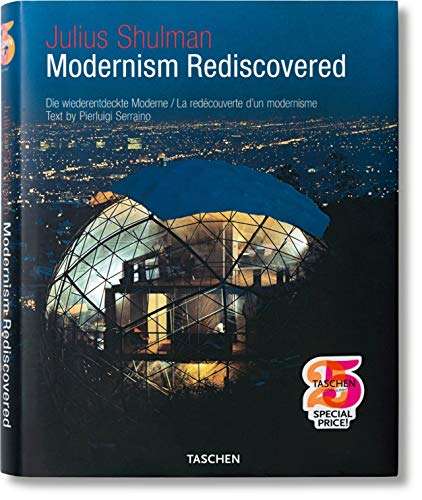Published by Taschen, 2009, hardcover, illustrated, 412 pages, 25.5 cms x 32.3 cms x 4.3 cms, condition: as new.
A LARGE COFFEE TABLE BOOK
The buildings burned in our memories, which to us represent the spirit of fifties and sixties architectural design, were those whose pictures were widely published in magazines and books; but what about those that got lost in the process? The exchange of visual information is crucial to the development, evolution, and promotion of architectural movements. If a building is not widely seen, its photograph rarely or never published, it simply does not enter into architectural discourse. Many buildings photographed by Julius Shulman suffered this fate, their images falling into oblivion. With this book, TASCHEN brings them to light, paying homage to California Modernism in all its forms. The abandoned files of Julius Shulman show us another side of Modernism that has stayed quiet for so many years. Bringing together nearly 250 forgotten masterpieces, Modernism Rediscovered pays tribute to these lesser known yet outstanding contributions to the modern architectural movement.
American photographer Julius Shulman's images of Californian architecture have burned themselves into the retina of the 20th century. A book on modern architecture without Shulman is inconceivable. Some of his architectural photographs, like the iconic shots of Frank Lloyd Wright's or Pierre Koenig's remarkable structures, have been published countless times. The brilliance of buildings like those by Charles Eames, as well as those of his close friend, Richard Neutra, was first brought to light by Shulman's photography. The clarity of his work demanded that architectural photography had to be considered as an independent art form. Each Shulman image unites perception and understanding for the buildings and their place in the landscape. The precise compositions reveal not just the architectural ideas behind a building's surface, but also the visions and hopes of an entire age. A sense of humanity is always present in his work, even when the human figure is absent from the actual photographs. Today, a great many of the buildings documented by Shulman have disappeared or been crudely converted, but the thirst for his pioneering images is stronger than ever before.
For decades, the California Dream meant the chance to own a stucco home on a sliver of paradise. The point was the yard with the palm trees, not the contour of the walls. Julius Shulman helped change all that.
In May 1960, the Brooklyn-born photographer headed to architect Pierre Koenigs Stahl House, a glass-enclosed Hollywood Hills home with a breathtaking view of Los Angelesone of 36 Case Study Houses that were part of an architectural experiment extolling the virtues of modernist theory and industrial materials. Shulman photographed most of the houses in the project, helping demystify modernism by highlighting its graceful simplicity and humanizing its angular edges. But none of his other pictures was more influential than the one he took of Case Study House No. 22. To show the essence of this air-breaking cantilevered building, Shulman set two glamorous women in cocktail dresses inside the house, where they appear to be floating above a mythic, twinkling city. The photo, which he called one of my masterpieces, is the most successful real estate image ever taken. It perfected the art of aspirational staging, turning a house into the embodiment of the Good Life, of stardusted Hollywood, of California as the Promised Land.
And, thanks to Shulman, that dream now includes a glass box in the sky.

